Winter survival is what separates the true preppers from people who occasionally watched Survivorman.
There is no harsher climate or more demanding atmosphere like a cold winter’s day with snow on the ground, and understanding how to navigate it means throwing out everything else that you knew going into this.
Surviving in winter isn’t easy, which is why I’m going to go down the most pertinent pieces of information you need to know to survive.
We’ll cover foraging, securing firewood, trapping, hunting, and the biggest issues that you may not have even realized. If you want to survive through the winter, then this guide was written for you.
What do You Need for Winter Survival?
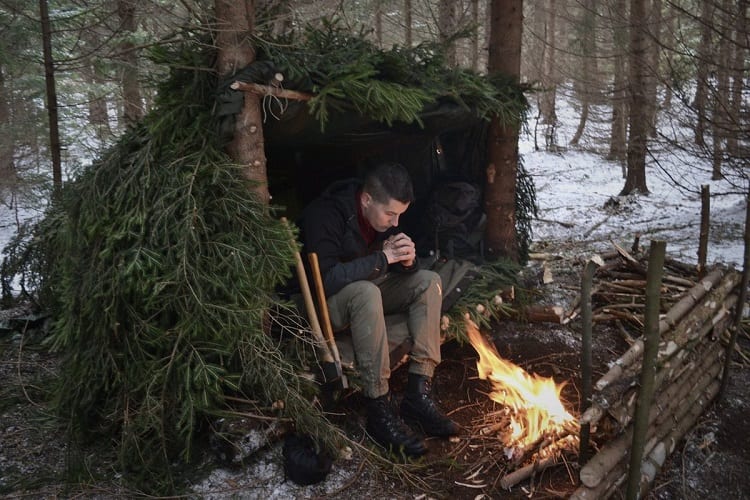
Heat, shelter, and food. That’s what you need to survive.
Winter is going to thaw at one point, and that’s when you can focus on upgrading your shelter or taking the time to have some leisure (entertainment items that you bring with you).
Heat
Perhaps the most obvious winter survival essential is a reliable heat source. Once you’ve decided on where you’re going to camp out in the wild, it’s time to dig yourself an old fashioned fire pit. You’re going to be out here for a while, so you’d might as well make the most of it.
Using a survival shovel that’s been freshly sharpened, carefully break the earth. Depending on how frozen the ground is, you may have to take this slowly so you don’t chip or bend the edge of your steel shovel.
Proceed with caution and make a circular hole in the ground, about four to six inches down.
Use large rocks and small stones to make a perimeter around the edge of the firepit. After digging up the soil, you should have a dry, snow-free spot to place your firewood (which we’ll teach you how to find later on).
The only tricky part here is making a cover over the fire so that snow doesn’t accumulate and make the remaining kindling soggy when the fire is out.
Shelter
Without shelter, you can’t hope to trap any amount of heat. It gets colder at night and your body temperature drops by one to two degrees when you’re winding down to go to sleep. This is a recipe for frostbite if you aren’t careful.
Your shelter isn’t going to be airtight, but it should be near your fire so that the warm air can continually keep you toasty through the night.
Shelter can be made out of tree branches, but you’re not going to find foliage during the winter. Instead, you should be using one or two emergency blankets and/or heat-ready tarps.
Using branches to make a frame, you can make a lean-to, cover it with an emergency blanket, and then make a makeshift tent out of it.
Alternatively, you can bring your own tent as long as you clear the ground before setting it up. Winter tents are viable solutions, but even then they’re still going to need some insulation on top of what the materials provide.
Food
Getting situated and figuring out how to hunt in winter is going to be its own challenge. Don’t make the first days any harder for yourself than they need to be. Bring some compact rations along with you, whether they’re MREs or something simple like protein bars.
One of the best things about winter is that your food will stay good for a lot longer than it would in summer. A fresh kill can be literally put on ice such as in a snowbank before you get around to cooking it. Sparser food sources, but longer expiration dates; it’s a trade-off.
Most bug out bags usually have 72 hours worth of food in MREs and high-calorie meals, but with winter, you don’t have the assurances that come with other seasons. Have six to ten days worth of food and water available in your bug out bag just to be safe.
Most Readily Accessible Food Sources are Gone
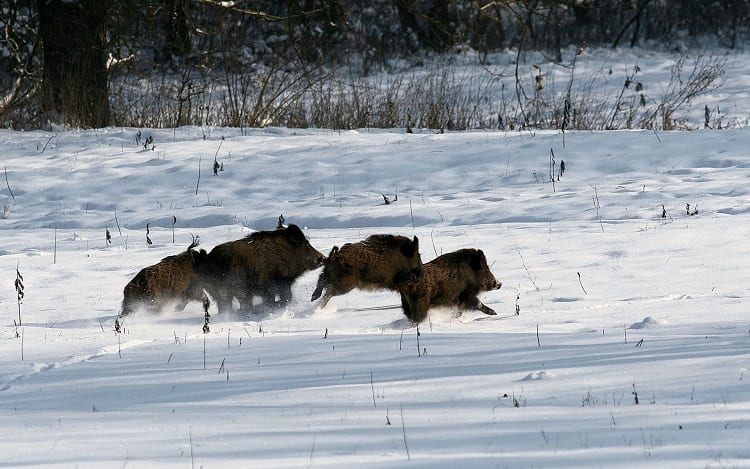
Foraging is your number one way to survive in the wilderness, except in winter. You still have some food and foliage available, but most of it is concealed under a blanket of snow, making it wildly inaccessible.
A lot of vegetation that you could find will be killed by the first frost, or at least wilt away. If you get to a location before winter strikes, you should take as much vegetation as possible before it gets killed off. Use preservation methods to keep it for as long as possible.
Your main source of food is going to come from animals. Rabbits and whitetail deer, mostly, although you can still river fish in some regions with moderate levels of success.
We’re going to go over foraging, but just know that you’ll turn up with smaller scraps of food from long hours of foraging, so it should be used primarily for diet variety.
How to Forage in Winter
Your best bet is going to be looking for vegetation and foliage that withstands the first frost. Seeds and fungi are also on the menu, so you’ll need to comb through the forest with a magnifying glass to find proper food sources.
The most difficult part about foraging in winter is simply not having a sufficient amount of food to find. You’ll have to increase your foraging area as opposed to searching in the spring or summer.
Stick to what you can see. You can’t possibly canvas everything under the snowy blanket on the ground, so search higher for the following common foods/foliages in North America.
- Juniper Berries
- Pine Nettles (Avoid Yew)
- Black Walnut Sap (Requires Tap)
- Acorns
- Maple Tree Seeds
- Rose Hip Berries
- Cranberries
- Hawthorn Berries
- Watercress
- Burdock
- Chicory Root
- Oyster Mushrooms
- Yellowfoot Chanterelles
- Kelp
It’s going to depend on what zone you’re in, but for the most part, these are plentiful foods that you can find throughout most of the winter.
Seeds stay for a long time, so they’re going to be your best bet. Keep roots in the ground until you’re ready to process and eat them. Last but not least, don’t underestimate the power of pine nettle tea when it’s frigid outside.
Trapping and Hunting
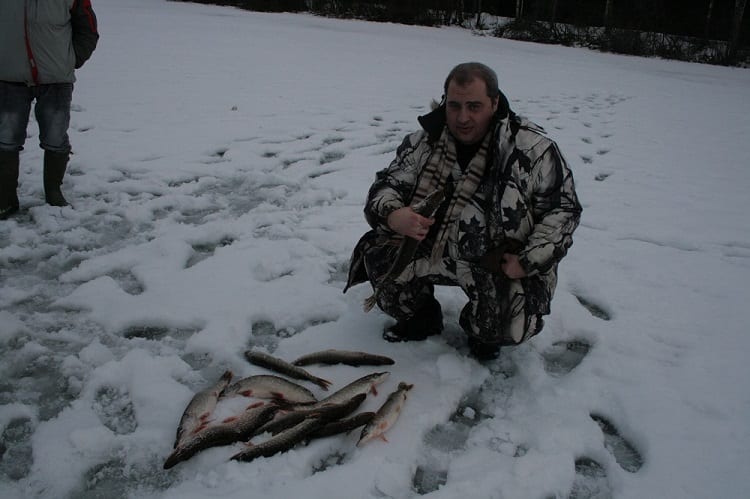
Hunting will prove difficult. If you pre-position a tree stand, you’ll be able to hunt whitetail in North America fairly easily, but most of us won’t have one of these in the event of bugging out since they’re heavy and bulky to carry.
You’ll want to stick to trapping if you’re entering a new hunting area. While there are less threats in winter for many prey animals, one gunshot could send them running for miles in every direction. Traps are mostly silent if you make them right.
In the United States, trapping rabbits during winter is an ideal source of protein. Because you can’t ignore the fact that whitetail are still around and viable food sources, it’s recommended that you either become skilled with a DIY bow and arrow, or bring a crossbow along with you.
These work for self-defense and intimidation, but they’re also predominantly silent ways that you can hunt without alerting other animals nearby.
How to Secure Firewood or Other Heat Sources
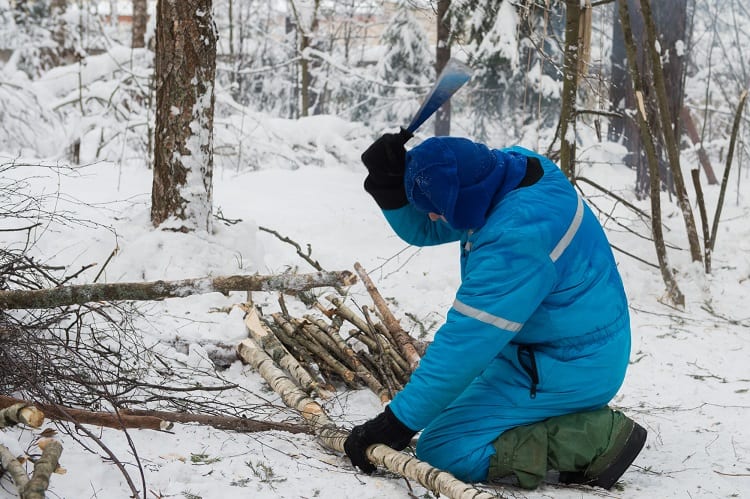
Keeping a fire alive is one of the biggest challenges of winter survival. You need an abundance of firewood and kindling to be able to feed to your fire no matter what. These are a few ways that you can secure that firewood so that your fire never goes out.
- Cut High: Trees are able to do something amazing: pulling water up higher than most modern piping can even allow. A tree can pull water up by one-hundred feet without mechanical intervention and feed those top branches. The further you are from the roots, the less water there is, so if you’re cutting firewood you want to cut high branches when available. This means that the wood will dry faster.
- Full Tarps: You don’t want to just cover your firewood from the top. Get a full-size tarp to wrap around an entire stockage of firewood. You want to protect your firewood from incoming snow, but you also have to account for melting periods.
- Bungee Cables: If you have the room, bring some bungee cables with you in your bug out bag. These will help you secure kindling such as branches, twigs, and smaller pieces of wood together without having a messy pile. Keep it neat and together to avoid melting periods turning your kindling into rot.
Firewood isn’t your only option in the wilderness. A solid survival shovel can also be used as a pickaxe, and you can locate coal in many backwater areas of the United States. Coal should be stored similarly to firewood with the intent of keeping it dry.
The Wind is Not Your Friend
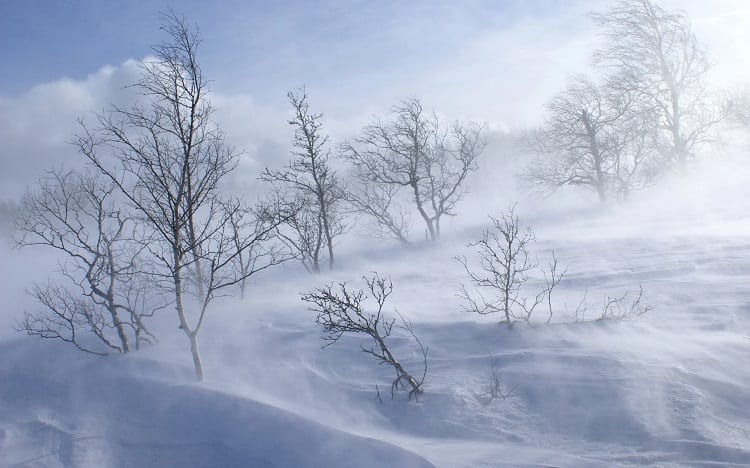
Wind chill is a beast. If you notice, every single winter when we have temperature reports and weather predictions, there’s a “RealFeel” rating. Either this, or you can find separate temperatures for wind chill.
In the middle of winter, a gust of wind can send shivers down your spine, even when you’re swimming in insulated gear. Wind chill can cause a lot of problems.
- Frostbite: This is the number one concern with excessive wind chill, which is why having covered shelter is so important right away. When tissue in your body freezes, you lose feeling in it, and depending on the severity of the damage that area may need to be amputated.
- Hypothermia: The average waking temperature of an adult is 98.6°F. For your body to fall into hypothermia, your internal temperature only needs to drop below 95.0°F. It’s not all that big a difference when you look at it, but the symptoms and bodily changes are alarming. Hypothermia is life-threatening.
- Exhaustion: The cold makes you tired, and as we know, our body temperature drops by 1.0°F up to 2.0°F when we sleep. Mix that with the wind chill bringing your body temperature down, and you have a recipe for disaster.
Melting Periods Will be a Problem
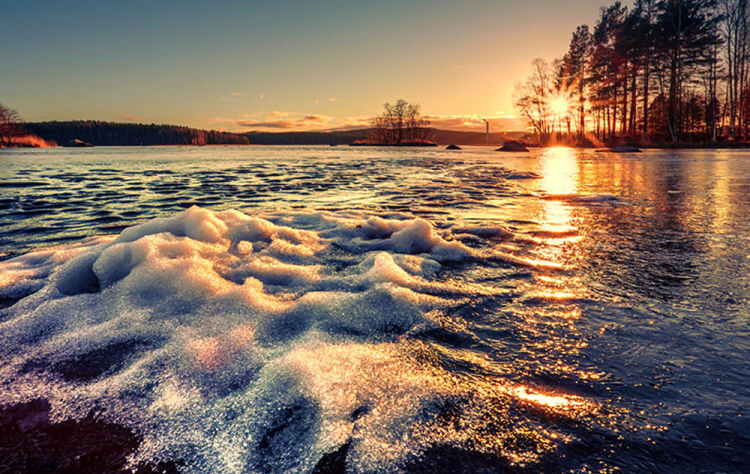
We just talked about wind chill. Having thick clothing to help prevent wind chill is excellent, but when the snow is just starting to melt on the ground, you run into a problem.
That clothing can become sodden if you trip, store it improperly, or if the ground floods from massive melt-off. Melting periods can be a big deal.
If the only clothing you have is wet, the wind chill is going to hit you twice as hard. You’ll feel that cold seep right through your clothes, and run the risk of entering hypothermia like we talked about earlier.
During melting periods, try to hoist your spare clothing up by a tarp to keep it dry in the event of a major melting period. Try to choose a campsite that isn’t on low ground when you make it into a winter wilderness location in the first place.
How to Keep a Fire Alive Overnight
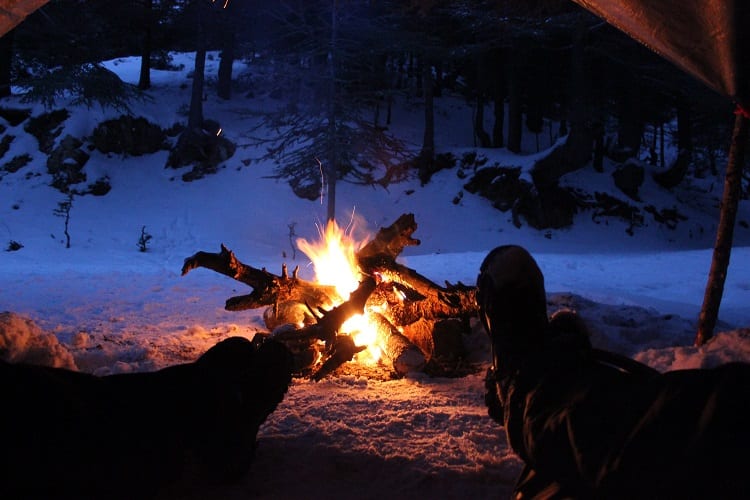
Your fire is your lifeline. It has to burn through the night to keep your body temperature up, and depending on how frigid the conditions are, this isn’t something that you can just half-ass and get better at.
You need to make a solid campfire that burns through the night right away. Here are some tips on how to do that.
Follow the Half-Inch Rule
Synonymous among all firestarter guides, this tip is perhaps the most useful. While this can vary based on the wood you use and how dry it is, it basically states that for every half-inch of wood, you have a half-hour of burn time.
In reality, most of these rules say that every half-inch gives you an hour of burn time, but we don’t want to leave anything up to chance in these conditions.
Ash Coating
Winter survival isn’t a one-day affair. After your first first, collect the ashes and keep them handy.
During your next fire, coat the firewood with a sprinkle of ashes. This makes the wood burn slower, giving you additional time every single night. Collect your ashes
Wind Protection
This one is a bit difficult. For wind protection, you could set up tarps as barriers, or you could let Mother Nature do the work for you.
Natural mounds, hills, and dirt walls can be used to cut down on the wind. Making your fire pit near natural cover like this will also give you a cozy area to settle your camp instead of being completely open on all sides.
Tipi Style Campfire
The way that you build a fire matters. There are tons of methods, but tipi-style campfires are best for winter. These create a small area with zero wind to allow you to build a fire.
From there, the fire beneath the tipi stacks of wood slowly burns, producing heat, and then slowly catching the remaining portion of wood on fire. It extends the life of the fire, but it also burns bright without needing thick, solid pieces of firewood.
Tarp Canopy
You have to be careful with placing this too close to the fire, but a flame retardant tarp can be of great use to make a canopy about ten feet up from the campfire.
It’s only going to protect against a little bit of wind, but the focus here is to keep snowfall from landing in your fire and extinguishing it while you sleep. To avoid a fire, seriously only use flame retardant tarps, and make sure it’s not so large that it will inhibit a ton of smoke from escaping.
Last Minute Winter Survival Tips
Before you go, take some of these basic winter survival tips into account.
- Set up your winter survival wear before a disaster happens and keep it near your bug out bag.
- Remember that heavy snow can be used to make a temporary shelter; it is an insulator.
- Always be worried about wind exposure and chill.
- Alcohol is a hindrance, not a benefit to staying warm.
- Never eat snow even in a last-ditch effort attempt at survival.
- Always be sure to pack medicine; your immune system is lowered in colder temperature.
- If you get sleepy during the day but you know that you’ve had enough sleep, seek out warmth immediately.
Winter is Unforgiving; You Are Unrelenting
Winter is the most unforgiving season. In summer, the heat dies down at night. In winter, it only gets colder. You’re up against the harshest elements, and your survival skills will either bend or break under these circumstances.
You have the resolve to survive, and now, you have the knowledge on what you need as well. Compile your bug out bag, make sure your insulation items are going to protect you, and learn the lay of the land before bugging out.
Have a bug out location in mind so that you know what to look for ahead of time. If possible, canvas an area now so that when the time comes, you know exactly where to go.


[lasso rel="emergency-preparedness-more-a-manual-on-food-storage-and-survival-2nd-edition-revised-and-updated" id="35334"]